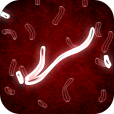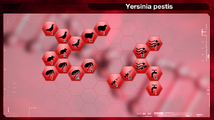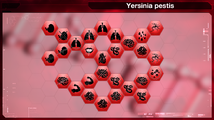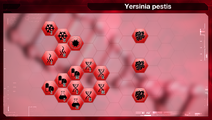Black Death
| General Information | Strategy Guides |
The Black Death is a plague type and scenario introduced with the Scenarios Update. In Plague Inc: Evolved, it needs to be beaten in order to unlock other scenarios. Its default name is its real-life scientific name, Yersinia pestis. This scenario was introduced in Mutation 1.7 released in 2013.[2]
Scenario Attributes
As a nod to its real-life counterpart, the Black Death Scenario automatically starts with the Bacteria selected as the pathogen chosen, with Yersinia pestis, its real-life scientific name, as its default name.
It starts with Flea 1, Fever, Coma, Necrosis, Buboes and Bubonic plague already evolved, and can't be devolved. These symptoms make it more difficult to cure, but, due to its high Severity and Lethality, it's very quickly detected, even with few Infected.[3]. Certain traits, such as the Rodent and Flea Transmissions, and the Hyper sensitivity Symptom, help the pathogen spread more easily in Urban Countries.[3]
According to the Chinese gaming website TGBUS, the disease being so severe at the beginning of the game makes it easy to obtain DNA points.[4]
Transmissions
- Flea 1 - 4: Fleas become sources of contagion, increasing Infectivity. Certain stages also increase other stats.

- Rodent 1 - 2: Rodents become sources of contagion, increasing Infectivity, specially in Urban Countries, and Mutation.

- Bird 1 - 2: Birds become sources of contagion, increasing Infectivity, Land Transmission and Mutation.

- Livestock 1 - 2: Livestock animals become sources of contagion, increasing Infectivity, specially in Rural Countries, and Mutation.

- Extreme Zoonosis: Infection crosses multiple species barriers. Increase infectivity, especially in rural and urban areas, mutation chance and cross-country transmission

- Air 1 - 2: Increases Pathogen's Infectivity, specially in Arid Climates and through Airplanes.

- Water 1 - 2: Increases Pathogen's Infectivity, specially in Humid Climates and through Boats.

- Extreme Bioaerosol: Pathogen bypasses air/water filters due to adaptive cellular shell. Increase infectivity, especially in humid & arid climates and plane/ship transmission.

Symptoms
- Rash: The skin becomes blistered and painful, slightly increasing infectivity.

- Cysts: Painful lumps containing pockets of the pathogen. Slight chance of bursting which can spread disease.

- Sweating: The loss of fluid through sweating also increases infection rates due to poor hygiene. More dangerous in cold countries.

- Hyper sensitivity: Increases likelihood of allergic reactions which can distract the immune system. Rich regions particularly vulnerable.

- Fever: Increase in temperature, contagiousness and severe dehydration which can be fatal.

- Inflammation: Inflammation obstructs bodily processes. Swelling can obstruct breathing and be fatal.

- Immune Suppression: Pathogens attach to lymphocytes, suppressing immune system and allowing significantly greater freedom of mutation. Can be lethal.

- Skin Lesions: Breakdown in the epidermis causes large open wounds which significantly increase infectivity.

- Seizures: Random Blackouts and fits reduce the patient's ability to function independently. Can be lethal.

- Paralysis: Pathogen destroys motor neurons to cause paralysis. Significantly harder to cure and can be lethal.

- Necrosis: Large swathes of infected tissue lose blood supply and become fatal source of gangrene. Decomposed bodies remain a vector of transmission.

- Coma: Neuropathic effects in the brain stem cause loss of consciousness and sometimes death. Significantly harder to cure.

- Buboes: Infected lymph nodes become swollen and inflamed. Bursting can aerosolise contents and infect others.

- Coughing: Chance of infection by spreading pathogen into surroundings, especially in high density urban areas.

- Pneumonia: Serious fluid build and discharge from the lungs. People in cold climates especially vulnerable.

- Sneezing: Fluid discharge through sneezing greatly increases infection rates.

- Pulmonary Oedema: Potentially fatal heart abnormality causes breakdown of respiratory system, releasing pathogen into the air.

- Haemoptysis: Coughing up blood from inflamed bronchi increases infectivity and is fatal in extreme cases.

- Nausea: Irritated stomach lining leads to discomfort. Slight chance of infection when kissing.

- Vomiting: The expulsion of infected material through projectile vomiting increases the risk of infection.

- Hypotension: Low blood pressure deprives organs of oxygen and nutrients, increasing severity and causing profound fatigue.

- Abscesses: Pockets of infected flesh are painful and act as breeding grounds for the pathogen, increasing infection rates when burst.

- Internal Haemorrhaging: Arterial membranes break down, causing rapid internal bleeding and death.

- Diarrhoea: Pathogen active in digestive tract, causing infection through faeces and potentially lethal dehydration. Poor countries very vulnerable.

- Hemorrhagic Shock: Severe loss of blood volume causes oxygen deprivation, loss of consciousness and death.

- Systemic Infection: Pathogen affects multiple organs and tissue types, causing body-wide infections that spread fast and can be lethal

- Dysentery: A complete breakdown in the digestive system causes infected sewage, dehydration, starvation and death.

- Total Organ Failure: Catastrophic cell death of multiple tissue types causes body-wide organ failure and rapid death.

Abilities
- Heat Resistance 1 - 2: Virus withstands higher temperatures easily, increasing Infectivity in Hot Countries.

- Cold Resistance 1 - 2: Virus withstands lower temperatures easily, increasing Infectivity in Cold Countries.

- Environmental Hardening: Pathogen develops hardened coating - becoming highly weather resistant and extremely comfortable in both hot and cold climates

- Drug Resistance 1 - 3: Virus resistant to all Antibiotics, increasing Infectivity in Rich Countries.

- Genetic ReShuffle 1 - 3: Virus reassembles its DNA and creates new strains, increasing the work required for a cure.

- Genetic Hardening 1 - 2: Virus harder to analyze in laboratories, increasing the work required for a cure.

- Hardened Reshuffle 1 - 2: Alters the Pathogen's DNA structure, which significantly increases Cure Requirement and work needed.

- Pneumonic plague: Gain ability to infect respiratory system and develop pneumonic form of plague. Airborne and virulent.

- Bubonic plague: Gain ability to infect lymphatic system and develop bubonic form of plague. Zoonotic and lethal.

- Septicemic plague: Gain ability to infect the blood stream and develop septicemic form of plague. Rare and very lethal.

Achievements

|
Achievement Name: | Complete Black Death | ||||
| Achievement Description: | Score 3 biohazards the Black Death scenario | |||||
| Value: | Difficulty: | Any | ||||
Gallery
References
- ↑ Nelson, Jared (2013-10-25). "New ‘Plague Inc.’ Scenario Update is Now Available". TouchArcade Retrieved on May 1, 2022.
- ↑ "Mutation 1.7 preview" (2013-10-17). Ndemic Creations Official Website Retrieved on September 29, 2022.
- ↑ 3.0 3.1 엘프리 (2017-07-28). "[전염병주식회사] 흑사병 시나리오 메가 난이도 공략". [[Plague Inc.] Black Death Scenario Mega Difficulty Strategy] Tistory (in Korean) Retrieved on September 29, 2022.
- ↑ Seven (2015-05-14). "瘟疫公司黑死病攻略 大国内开局日本灭亡". [Plague Inc. Black Death Strategy] TGBUS (in Simplified Chinese) Retrieved on September 29, 2022. Quote: “”由于开始它的严重性有点高,相对它获得DNA能力也就相当优秀,特别要注意的是在绝大部分人被传染之前一定不要加致死的症状(最好是在都被传染再加死亡症状) [Since its severity is a bit high at the beginning, its ability to obtain DNA is also quite good. Special attention must be paid to not add lethal symptoms before most people are infected (it is best to add death symptoms when they are all infected. )]




